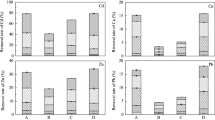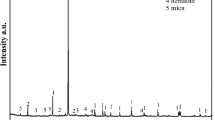Abstract
Soils polluted by metals and organic compounds are a major challenge in soil remediation and environmental recovery; however, the technology to efficiently decontaminate soils polluted by both metal and organic pollutants does not yet exist. Most of these soils are disposed of in landfills. This study first evaluates chemical reagents (hydrochloric, nitric, sulfuric and lactic acids and ethanol) for leaching metals from soil. Assays were then conducted to evaluate non-ionic, ionic and amphoteric surfactants for pentachlorophenol (PCP) removal by flotation. Finally, a laboratory-scale leaching/flotation process was applied to treat four soil samples polluted with both organic ([PCP]i = 2.5–30 mg kg−1) and metals ([As]i = 50–250 mg kg−1, [Cr]i = 35–220 mg kg−1, [Cu]i = 80–350 mg kg−1) compounds. The organic compounds and metals are concentrated in the froth and liquid fractions, respectively. Removal yields of 82–93 %, 30–80 %, 79–90 % and 36–78 % were obtained from As, Cr, Cu and PCP, respectively, under optimized process conditions (H2SO4 = 1 N, [cocamidopropyl betaine]i = 1 % (w w−1), t = 60 min, T = 60 °C, PD = 10 % (w v−1)). The treatment of the produced leachate was also tested by chemical precipitation using different reagents.




Similar content being viewed by others
References
ADEME. (1998). Connaître pour agir. Angers, France: Guides et cahiers techniques.
Augustijin-Beckers, P. W. M., Hornsby, A. G., & Wauchope, R. D. (1994). SCS/ARS/CES pesticide properties database for environmental decision making: II. Additional compounds. Reviews of Environmental Contamination and Toxicology, 137, 6–16.
Banerji, S. K., Wei, S. M., & Bajpai, R. K. (1993). Pentachlorophenol interactions with soil. Water, Air, and Soil Pollution, 69(1–2), 149–163.
Barnes, H. M. (2008). Wood preservation trends in North America forest products laboratory. Mississippi: Forest and Wildlife Research Center, Mississippi State University.
Blais, J. F., Djedidi, Z., Ben Cheikh, R., Tyagi, R. D., & Mercier, G. (2008). Metals precipitation from effluents. A review. Practice Periodical of Hazardous, Toxic, and Radioactive Waste Management, 12(3), 135–149.
Bouchard, S. (2001). Traitement du minerai. Québec, QC, Canada: Le Griffon d'argile. 373 p.
U.S. Congress. (1995). Cleaning up contaminated wood-treating sites, OTA-BP-ENV-164. Washington, DC: Office of Technology Assessment, U.S. Government Printing Office.
Czaplicka, M. (2006). Photo-degradation of chlorophenols in the aqueous solution. Journal of Hazardous Materials, B134, 45–59.
Dermont, G., Bergeron, M., Mercier, G., & Richer-Laflèche, M. (2008). Soil washing for metal removal: a review of physical/chemical technologies and field applications. Journal of Hazardous Materials, 152, 1–31.
Di Corcia, A. (1973). Analysis of phenols by gas/liquid/solid chromatography. Journal of Chromatography, 80, 69–74.
DiVincenzo, J. P., & Sparks, D. L. (2001). Sorption of the neutral and charged forms of pentachlorophenol on soil: evidence for different mechanisms. Archives of Environmental Contamination and Toxicology, 40, 445–450.
Elgh-Dalgren, K., Arwidsson, Z., Camdzija, A., Sjöberg, R., Ribé, V., Waara, S., et al. (2009). Laboratory and pilot scale soil washing of PAH and arsenic from a wood preservation site: changes in concentration and toxicity. Journal of Hazardous Materials, 172, 1033–1040.
Gräfe, M., Tappero, R. V., Marcus, M. A., & Sparks, D. L. (2008). Arsenic speciation in multiple metal environments: II. Micro-spectroscopic investigation of a CCA contaminated soil. Journal of Colloid and Interface Science, 321, 1–20.
Groenier, J. C., & Lebow, S. (2006). Preservative-treated wood and alternative products in the forest service. Missoula, Manitoba, Canada: USDA Forest Service Technology and Development Program. TE42G01—Technical Services ECAP.
Janin, A., Blais, J. F., Mercier, G., & Drogui, P. (2009a). Optimisation of a chemical leaching process for decontamination of CCA-treated wood. Journal of Hazardous Materials, 169, 136–145.
Janin, A., Blais, J. F., Mercier, G., & Drogui, P. (2009b). Selective recovery of metals in leachate from chromated copper arsenate treated wood using ion exchange resins and chemical precipitation. Journal of Hazardous Materials, 169, 1099–1105.
Janin, A., Blais, J. F., Drogui, P., Zaviska, F., & Mercier, G. (2009). Selective recovery of metals in leachate from chromated copper arsenate wastes using electrochemical technology and chemical precipitation. Hydrometallurgy, 96, 318–326.
Johnson, T. (2008). Bioremediation and detoxification of polychlorinated dioxin contaminated environments. MMG 445. Basic Biotechnology eJournal, 4, 1–9.
Kabata-Pendias, A. (2001). Trace elements in soils and plants (3rd ed.). Boca Raton, FL: CRC Press. 413 p.
Khodadoust, A. P., Suidan, M. T., Acheson, C. M., & Brenner, R. C. (1999). Solvent extraction of pentachlorophenol from contaminated soils using water–ethanol mixtures. Chemosphere, 38(11), 2681–2693.
Khodadoust, A. P., Reddy, K. R., & Maturi, K. (2005). Effect of different extraction agents on metal and organic contaminant removal from a field soil. Journal of Hazardous Materials, 117(1), 15–24.
Kudaibergenov, S. K. (2002). Polyampholites: Synthesis, characterisation and applications. New-York, NY: Kluwer Academic/Plenum. 220 pp.
Kumar, Y., Popat, K. M., Brahmbhatt, H., Ganguly, B., & Bhattacharya, A. (2008). Pentachlorophenol removal from water using surfactant-enhanced filtration through low-pressure thin film composite membranes. Journal of Hazardous Materials, 154, 426–431.
Lee, L. S., Suresh, P., Rao, C., Nkedi-Kizza, P., & Delfino, J. J. (1990). Influence of solvent and sorbent characteristics on distribution of pentachlorophenol in octanol–water and soil–water systems. Environmental Science and Technology, 24(5), 654–661.
Lee, M. R., Yeh, Y. C., Hsiang, W. S., & Hwang, B. H. (1998). Solid-phase microextraction and gas chromatography–mass spectrometry for determining chlorophenols from landfill leaches and soil. Journal of Chromatography, 806, 317–324.
Lespagnol, G. (2003). Lixiviation du chrome, du cuivre et de l’arsenic (CCA) à partir de sols contaminés sur des sites de traitement du bois. PhD thesis, École Nationale Supérieure des Mines de Saint-Etienne et de l’Université Jean Monnet, France.
Lippmann, M. (2000). Environmental toxicants. Human exposures and their health effects. New York, NY: John Wiley & Sons Inc.. 987 p.
Mercier, G., Duchesne, J., & Blackburn, D. (2001). Prediction of metal removal efficiency from contaminated soils by physical methods. Journal of Environmental Engineering, 127(4), 348–358.
Mercier, G., Mouton, J., Blais, J. F., Drogui, P., & Chartier, M. (2008) Procédé, décontaminant et kit chimique pour la décontamination de milieux pollués par des métaux et des composés organiques hydrophobes. Canadian Patent Pending No. CA 2,701,000.
Mouton, J., Mercier, G., & Blais, J. F. (2008). New amphoteric surfactants for polluted-soil treatment using flotation. Water, Air, and Soil Pollution, 197(1), 381–393.
Mouton, J., Mercier, G., Drogui, P., & Blais, J. F. (2009). Experimental assessment of an innovative process for simultaneous PAHs and Pb removal from polluted soils. Science of the Total Environment, 407, 5402–5410.
Mouton, J., Mercier, G., & Blais, J. F. (2010). Laboratory scale flotation process for treatment of soils contaminated with both PAH and lead. Journal of Environmental Engineering, 136(10), 1063–1074.
Mulligan, C. N., & Eftekhari, F. (2003). Remediation with surfactant foam of PCP-contaminated soil. Engineering Geology, 70, 269–279.
Norton, D., Zheng, J., Danielson, N. D., & Shamsi, S. A. (2005). Capillary electrochromatography-mass spectrometry of zwitterionic surfactants. Analytical Chemistry, 77, 6874–6886.
Olea, A. F., & Gamboa, C. (2003). Solubilisation of phenols in surfactant/polyelectrolyte systems. Journal of Colloid and Interface Science, 268(1), 63–67.
Park, S. K., & Bielefeldt, A. R. (2003). Aqueous chemistry and interactive effects on non-ionic surfactant and pentachlorophenol sorption to soil. Water Research, 37, 4663–4672.
Paterson, I. F., Chowdhry, B. Z., & Leharne, S. A. (1999). Polycyclic aromatic hydrocarbon extraction from a coal tar-contaminated soil using aqueous solutions of nonionic surfactants. Chemosphere, 38(13), 3095–3107.
Peters, R. W. (1999). Chelant extraction of heavy metals from contaminated soils. Journal of Hazardous Materials, 66, 151–210.
Sahle-Demessie, E., Grosse, D. W., & Bates, E. R. (2000). Solvent extraction and soil washing treatment of contaminated soils from wood preserving sites: Bench-scale studies. Cincinnati, OH: USEPA, Remediation, Summer.
Stasiuk, E. N. B., & Schramm, L. L. (1996). The temperature dependance of the critical micelle concentrations of foams-forming surfactants. Journal of Colloid and Interface Science, 178, 324–333.
Subramanian, B. (2007). Exploring neoteric solvent extractants: Applications in the removal of sorbates from solid surfaces and regeneration of automotive catalytic converters. Cincinnati, OH: Division of Research and Advanced Studies of the University of Cincinnati.
Tessier, A., Campbell, P. G. C., & Bisson, M. (1979). Sequential extraction procedure for the speciation of particulate trace metals. Analytical Chemistry, 51(7), 844–851.
Tse, K. K. C., & Lo, S. L. (2002). Desorption kinetics of PCP-contaminated soil: effect of temperature. Water Research, 36, 284–290.
Tsuda, T., Takino, A., Kojima, M., Harada, H., & Muraki, K. (1999). Gas chromatographic–mass spectrometric determination of 4-nonylphenols and 4-tert-octylphenol in biological samples. Journal of Chromatography B, 723, 273–279.
USEPA (1992). BioTrol soil washing system for treatment of a wood preserving site, applications analysis report. EPA/540/A5-91/003. Cincinnati, Ohio: Risk Reduction Engineering Laboratory, Office of Research and Development, U.S. Environmental Protection Agency. 76 p.
Walter, I., & Cuevas, G. (1999). Chemical fractionation of heavy metals in a soil amended with repeated sewage sludge application. Science of the Total Environment, 226, 113–119.
You, C. N., & Lui, J. C. (1996). Desorptive behaviour of chlorophenols in contamined soils. Water Science and Technology, 33(6), 263–270.
Zagury, G. J., Dobran, S., Estrela, S., & Deschênes, L. (2008). Inorganic arsenic speciation in soil and groundwater near in-service chromated copper arsenate-treated wood poles. Environmental Toxicology and Chemistry, 27(4), 799–807.
Acknowledgments
Sincere thanks are extended to the National Sciences and Engineering Research Council of Canada for their financial contribution to this study.
Author information
Authors and Affiliations
Corresponding author
Rights and permissions
About this article
Cite this article
Reynier, N., Blais, JF., Mercier, G. et al. Treatment of Arsenic-, Chromium-, Copper- and Pentachlorophenol-Polluted Soil Using Flotation. Water Air Soil Pollut 224, 1514 (2013). https://doi.org/10.1007/s11270-013-1514-4
Received:
Accepted:
Published:
DOI: https://doi.org/10.1007/s11270-013-1514-4




